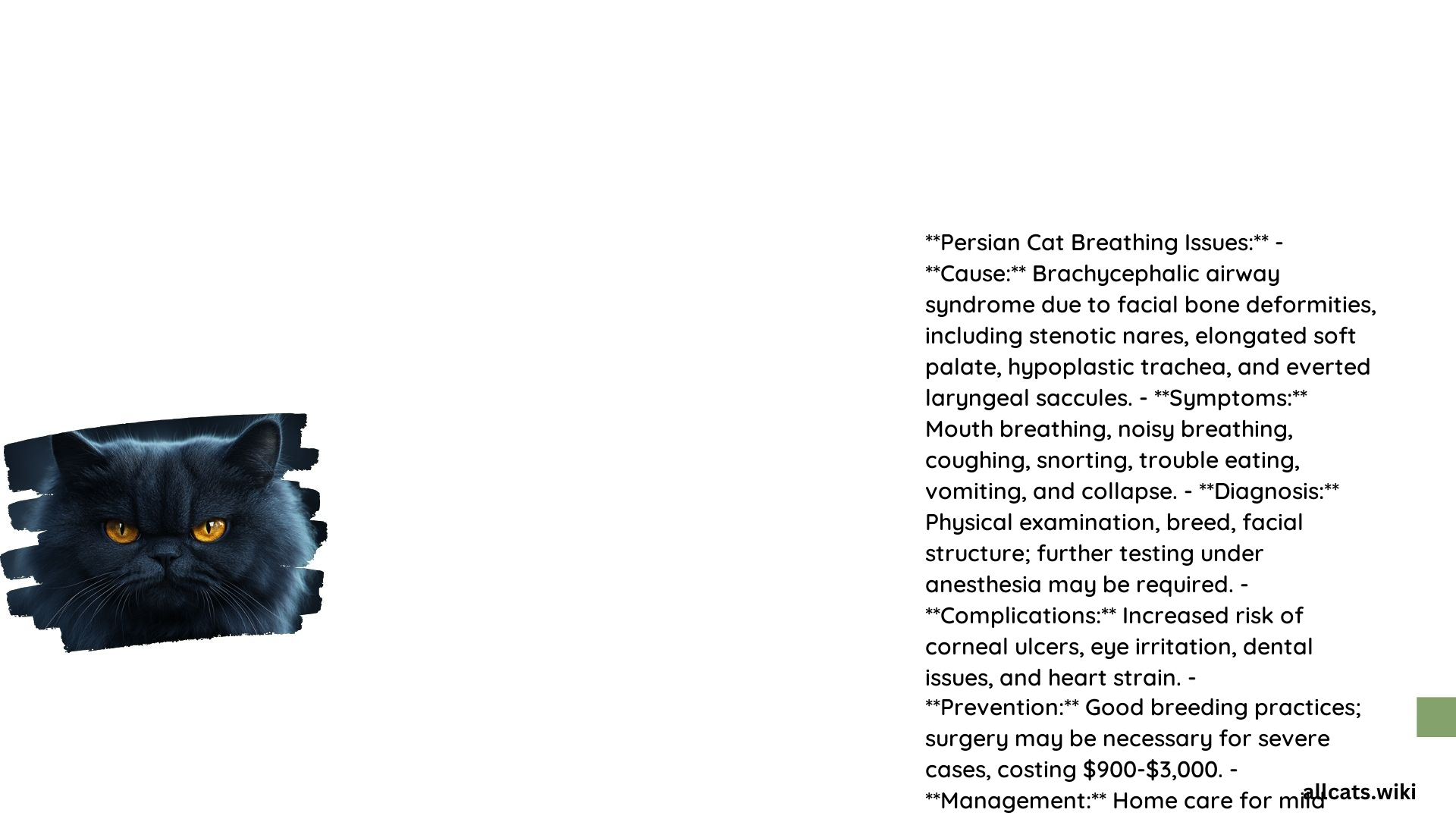Persian cats are known for their distinctive flat faces and long, luxurious coats, but these physical traits can also lead to significant breathing problems. Brachycephalic Airway Syndrome (BAS) is a common condition in Persian cats, causing various respiratory issues that can impact their quality of life. In this comprehensive blog post, we’ll explore the common signs of BAS, the diagnostic process, and the long-term effects and ongoing care required for Persian cats with breathing difficulties.
What are the Common Signs of Brachycephalic Airway Syndrome in Persian Cats?

Persian cats with Brachycephalic Airway Syndrome may exhibit a range of symptoms and observable behaviors, including:
| Symptom | Description |
|---|---|
| Difficulty Breathing | Labored breathing, increased respiratory effort, especially during inspiration |
| Open-Mouth Breathing | Unlike normal cats, Persian cats may need to breathe with their mouths open to get sufficient oxygen |
| Noisy or Raspy Breathing | Snoring, snorting noises, and other abnormal breathing sounds |
| Increased Respiratory Effort | More pronounced chest movements due to the strain of breathing |
| Cyanosis | In severe cases, cats may turn cyanotic (gray or bluish color to the gums and tongue) due to insufficient oxygen |
| Exercise Intolerance | Persian cats may tire easily or collapse after minimal exertion due to the strain of breathing |
| Heat Intolerance | These cats often have difficulty in hot weather, which can exacerbate breathing issues |
| Other Symptoms | Coughing, gagging, frequent retching or vomiting, and restlessness |
How is Brachycephalic Airway Syndrome in Persian Cats Diagnosed?

The diagnosis of Brachycephalic Airway Syndrome in Persian cats typically involves a combination of physical examination, anesthesia, pre-anesthetic testing, and endoscopic examination. Here’s a closer look at the diagnostic process:
Physical Examination
The diagnosis often starts with a thorough physical examination, focusing on the cat’s breed, facial structure, and external physical features.
Anesthesia
A comprehensive examination of the laryngeal and soft palate structures typically requires anesthesia, as these areas are difficult to inspect in an awake cat.
Pre-Anesthetic Testing
Before the anesthetic procedure, the veterinarian may perform blood tests to check internal organ function, chest X-rays to evaluate the heart and lungs, and an EKG to screen for heart abnormalities.
Endoscopic Examination
An endoscope may be used to examine the trachea and upper airway, allowing the veterinarian to assess the severity of the airway obstruction.
Blood Work
Additional blood tests may be conducted to check CO2 and pH levels, providing insights into the extent of the cat’s breathing problems.
The average cost of surgery for treating Brachycephalic Airway Syndrome in Persian cats can range from $100 to $1,000, with an average cost around $500. The diagnostic process can be completed within a few days to a week, depending on the availability of the veterinarian and the need for additional testing.
What are the Long-Term Effects and Ongoing Care for Persian Cats with Breathing Issues?
Persian cats with Brachycephalic Airway Syndrome may face a range of long-term health complications and require ongoing care to manage their condition effectively.
Health Complications
- Respiratory Issues: Chronic breathing difficulties can lead to frequent respiratory infections and exacerbate existing conditions.
- Dental Problems: The brachycephalic skull structure can also lead to dental issues such as overcrowding and malocclusion.
- Eye Problems: Persian cats with brachycephaly are at higher risk for eye issues like epiphora (tears running onto the face) and corneal ulcers.
- Skin Infections: The facial folds can be prone to skin infections.
- Heat Stroke: These cats are more susceptible to heat stroke due to their breathing difficulties.
Ongoing Care
- Regular Veterinary Check-ups: Routine veterinary check-ups are crucial to monitor the condition and adjust treatment plans as needed.
- Environmental Adjustments: Keeping the environment cool, especially in hot weather, can help alleviate symptoms.
- Dietary Considerations: A balanced diet and maintaining a healthy weight can help reduce the strain on the respiratory system.
Necessary Products or Interventions
- Surgical Interventions: Surgery may be necessary to correct stenotic nares, elongated soft palate, and other airway obstructions.
- Medications: In some cases, medications may be prescribed to manage symptoms such as respiratory infections or to reduce swelling in the airways.
- Supportive Care: Providing a cool, quiet environment and ensuring the cat does not overexert itself can help manage the condition.
By understanding the common signs, diagnostic process, and long-term care required for Persian cats with Brachycephalic Airway Syndrome, pet owners can work closely with their veterinarians to provide the best possible care and improve the quality of life for their beloved feline companions.
